Goechala Trek
Fitness Regime for your Himalayan Treks (Comprehensive plan to make you fit for any trek in 4 weeks)
Goechala Trek is best known for its grand view of 14 highest mountains of the Himalayas, out of which the World’s third highest mountain Mt Kanchenjunga dominates the most. That is a lot for any trekker who wishes to be in the close proximity of High mountains of Kanchenjunga range. No doubt this trek is the most favorite among the trekkers. The high point of the trek is when the first ray of sun rise falls on the Kanchenjunga range. The whole mountain range shines like a golden chain. Beside that trekking in the flowering season I.e., Spring season of the region is another eye candy for trekkers. The whole trail seems like a carpet of red flower of Rhododendron.
This trek holds some of the best trekking trail in India. You able to spot the blue sheep of mountains, the wild yaks and the beautiful snow leopards. Also don’t forget the cutest animal of all the red panda could also be spotted here in the Spring season of the year. Beside this the trek also hold some rare birds like snow pigeons, red beak crow and the most beautiful Himalayan Monal. The samiti lake is another big attraction on Goechala Trek. The reflection of Mt Pandim in the deep blue water of Samiti Lake is a visual treat for trekkers.
1.Trek Route The most well-known path which the trekkers can take depending on their skill, accommodation, and feasibility is the one that takes you through Dzongri from Phedang, right to Thangsing, and up till Goecha La. One additionally has the choice of picking the route via Dzongri, and trek tough from Phedang, however, which would simply mean you will lose the manifestation of the entire trek.
2. Base Point You can prefer a non-stop flight from Delhi to West Bengal which is the nearest air terminal from Gangtok and would then be able to take a taxi till the Yuksom from where you can start your Goecha La trekking. You can likewise take a train from either Delhi or Kolkata to Jalpaiguri railway station. A few travelers travel through the road if starting from Darjeeling or Kolkata according to their preference.
3. Estimate Duration For the individuals, who intend to adhere to the standard itinerary which would get the job done to experience the entire trek in the manner, it ought to be, it should not take over 11 days to cover the whole Goecha La trek and coming back. However, for those trekkers who'd prefer to take as much time as is needed or go through a day or two extra as per their convenience and capture more photos.
4. Best Time The most suitable time for Goecha La trekking is throughout the spring season between the long stretches of April and June or late during harvest time somewhere close to September and October. It is advisable to avoid the trek between June to September as the monsoon storm makes it inclined to avalanches and sloppy tracks. Likewise, during December, it additionally dangerous as the substantial snowfall makes the trekking troublesome, and the temperature drops down as low as -25 degrees Celsius in specific districts.
5. Famous Attractions The Dzongri mountaintop is the best attraction of the Goecha La trek that enables voyagers to sustain their hungry spirits with the amazing 360-degree perspectives on the mountains and their snow-topped summits. This mountaintop is situated on top of the charming background of the Himalayan Range. Lavish green and untainted, Yuksom is a delightful town in Sikkim that one must travel on their Goecha La Trek. Apart from natural excellence, what will astonish you is the welcoming treatment and benevolence of local people who always welcome bystanders with their cute happy faces. Situated at a height of 3000 meters, Tsokha is a tiny depot in the Kanchenjunga National Park that assists as an ideal overnight stay for trekkers. It is famous for furnishing voyagers with the most breathtaking scenes of the sunrise over Mt. Pandim. Try to reach this spot early to enjoy the sunset as well. Protected in the thick forests of magnolia, orchids, rhododendron, and plants, Bakhim is exactly like heaven where trekkers can take pause and appreciate the picturesque scene. The all-encompassing panoramas on the valleys, slopes, and the Prekchu River will fill your heart with pure happiness. Enriched with a silent small river and flashing meadows, Thangsing gives as an enchanting night stay to trekkers. Apart from being a beautiful location, Thangsing is additionally a shelter for night shutterbugs who can dwell here and catch grand perspectives on the Milky Way. Take as many photos as you can and show it to your family and friends. Probably the greatest highlights of the Goecha La trek is the sunrise scene on the Kanchenjunga peak. Although trekkers are not permitted to go till the end of the Goecha Pass, the view from Dzongri merits an exorbitant price! It is worth the efforts and dedication you have put to reach this place.
6. Advice This campaign is the ideal experience to appreciate the rush of the Himalayas, yet it holds amazingly ruthless conditions and is commonly considered to have the highest degree of difficulty. Get ready with the attire and other defensive apparatuses to persevere through the unusual mountain climate, as it might get freezing. Keep your trekking gear safe and keep basics, for example, a breeze proof coat, caps, and dry socks nearby.
7. Trek Cost A standard cost for an individual for an 11-day trek which incorporates the expense of daily convenience, suppers, and miscellaneous costs that incorporates the permit charge, tents for outdoors, trekking gear. Sometimes the trek gets entirely challenging, while on different occasions it shows up as simple as some other treks in Sikkim. If you are searching for some pleasure and adventure alongside the experience and rush of trekking in Sikkim, it is the ideal call for you! Alongside a beautiful path, pleasant mountains, tight passes, and a flawless viewpoint, the Goecha La trek offers wonderful perspectives.
In the eastern part of the Himalayas, there breathe a small province of Sikkim resided by the friendly, socially rich, and welcoming individuals. Here individuals of various tribes, to be specific, Lepchas, Bhutias, Subbas, Rai, and Limbos all live unitedly in a rich social unity making this state a touristic paradise. Here, the yaks and dzos are the relatives, and the relentless Kanchenjunga takes care of all of them. Enjoy a charming and adventurous trek through groves, lavish fields, and mesmerizing blue waters accompanying the path. Acknowledged as the beautiful trekking paths in the nation, get ready to be fascinated by the breathtaking cliffs, the interesting individuals, their peculiar culture, and the wonderful path that leads you to join in a stunning encounter. This Goecha La trek plan will make your trekking experience problem-free and a never forgettable encounter. The Kanchenjunga National Park is a home of several wildlife animals, like Red Panda, which is most famous among all as it’s a state animal of Sikkim and a very rare sight because of its shy personality. Yes they are rare and only a few are left but it is worth trekking this distance for just get a glance of this beautiful creature. The best suitable months to do this trek is post and before the monsoon, i.e. after September mid to October and early April to Mid May as it gives amazing clear sunrise and Mountain View. These months are best because of its blooming season of Rhododendrons flowers and the probability of season a Red Pandas are much more than other seasons. (Keep looking for thin green bamboos and trees beside).
COVID-19 Safety & Guidelines:
Short Itinerary
Day 1:
- Getting to Yuksom. (5,839 ft) Pickup from NJP station is at 9 am till 3 pm one day prior to the trek date.
Day 2:
- Bakhim– (9,701 ft.) through Sachen from Yuksom – Distance: 14 km
Day 3:
- Tshoka – (9,701 ft.) from Bakhim – Distance: 14 km
Day 4:
- Dzongri – (10449 ft) from Tshoka – Distance: 10km
Day 5:
- Dzongri Top (13943.57) to Dzongri – Distance: 2km
Day 6:
- Dzongri (13,024 ft) to Thansing (12,946) ft via Kockchurang (12,152 ft)
Day 7:
- Thansing (12,946 ft) to Goechala View Point One (15,100 ft) via Samiti Lake, back to Kockchurang / Thansing (12,152 ft / 12,946 ft)
Day 8:
- Kockchurang / Thansing (12,152 ft / 12,946 ft) to Tshoka (9,701 ft); 6-7 hours
Day 9:
- Tshoka (9,701 ft) to Yuksom (5,3839 ft);
Day 10:
- Drive from Yuksom (5,643 ft) to NJP. You will reach NJP by 5 pm
Price Inclusions
- Accommodation
- Breakfasts
- Lunch
- Dinner
- Bonfire
- Guide
- Permit
- Snack/Tea
- Lots and lots of FUN.
Price Exclusions
- Jeep Arrangement
- Arrival day accommodation and food.
- Any kind of insurance.
- Porters could be arranged and the costing is borne by the Participant
- Personal Expense:( snacks, mineral water, etc)
- Anything not included above
Stay
- Homestay/Tea House/ Tented Accommodation
- Sharing basis accommodation
- Separate accommodation for boys and girls
Meal
- We offer hot vegetarian food.
- breakfasts
- lunch
- dinner
- Tea/Snacks
Transportation
- We usually try to arrange a Tavera/Qualis Jeep for Pickup and Drop from/to NJP or Bagdogra Airport.
- The travel time from NJP to Yuksom is about 5-6 hours. The cost of transportation is Rs. 5500 per cab (5-6 people).
- Departure from Yuksom to NJP. (5-6 hours travel time) The Cost of the Cab from Yuksom to NJP Station is Rs 5500 (5-6 people).
- You will reach NJP Station or Bagdogra Airport approximately by 8 pm. (We request you to do the onward journey after 8 pm from NJP).
- The cost of Arrival and Departure Jeep is shared among the trekkers using the Jeep.
Pickup Points
- This are pickup location for our treks as follows:
- NJP Railway Station
- Bagdogra Airport
- Pickup from NJP station will be from 9 am till 3 pm one day prior to the trek date.
- Please select the pickup location from the drop-down list while booking.
-
- Any change in Pick up locations/ timings would be updated via mail 24 hours before the start of the trip
- Drop-off points shall be the same as the pick-up points.
Detail Itinerary
Day 1: Reach Yuksom
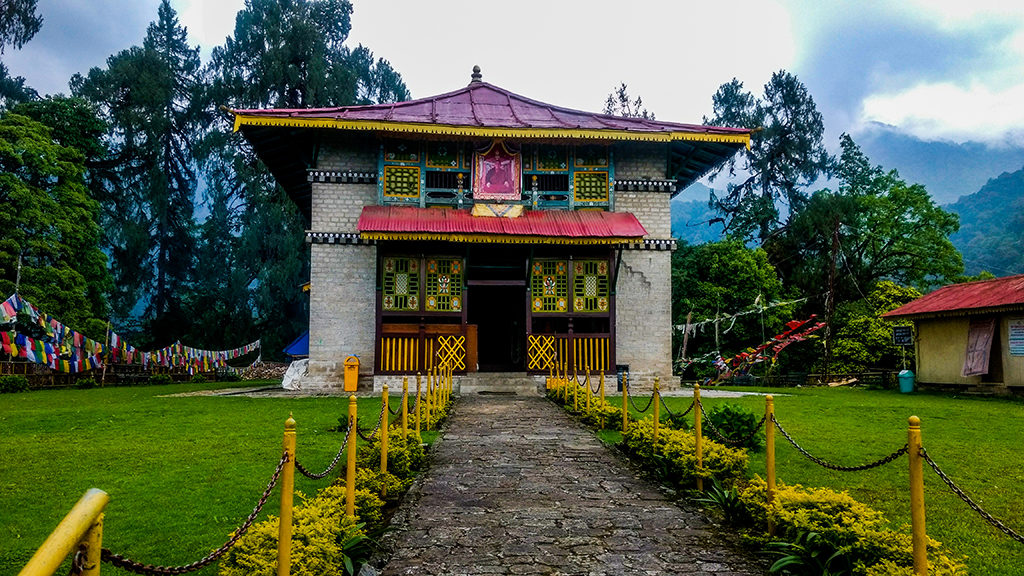
It would take 6 to 8 hours to reach Yuksom from Siliguri. The trek starts the next day of your arrival. There are two things we need to do at Yuksom before we start our trek to Goechala. First thing is an entry at the local police station. So, please carry a photo id proof with three photo copies. Second, you need to pay permit fees at the forest check post. Our trek leader or guide will help you do this activity. The overall charge for the fee is about Rs 700. Please note camera charges are extra. If you are a foreigner, please find the necessary permit you need at the end of the page.
Day 2: Yuksom to Sachen/Bakhim
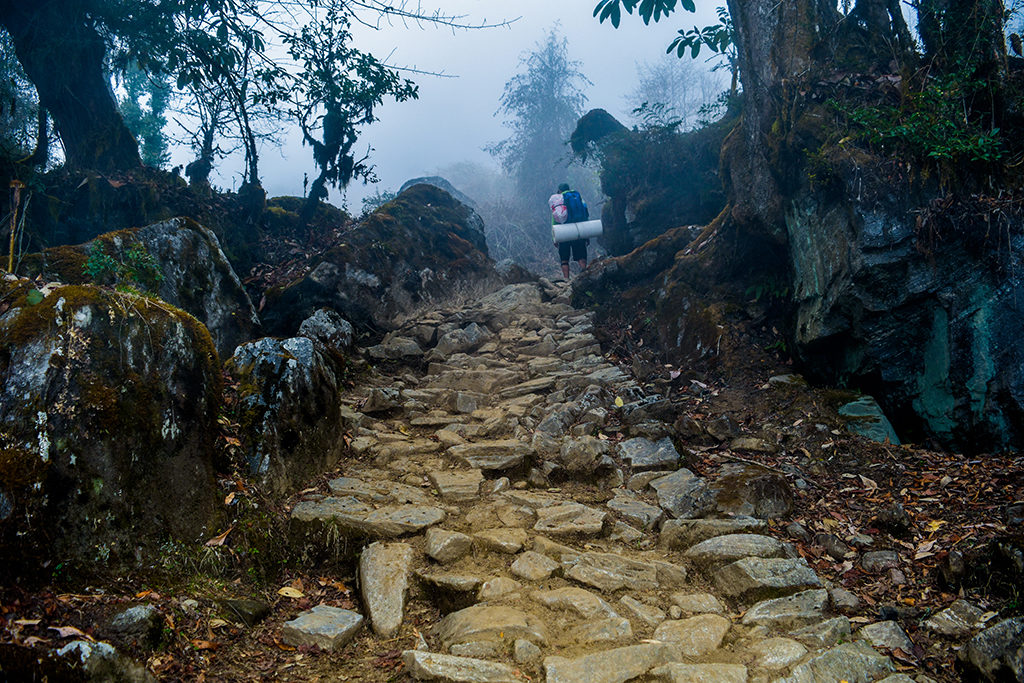
After we cross the first bridge Pha Khola, the trail climbs gradually, After the camel hump climb and descend, the next hour and half is a pleasant walk through the tall trees. There are multiple hydrations point on this route. We switch the mountains side from left to right on the large iron bridge above Tshushay Khola. We usually stop here to explore the beautiful multiple mini waterfalls at this point.
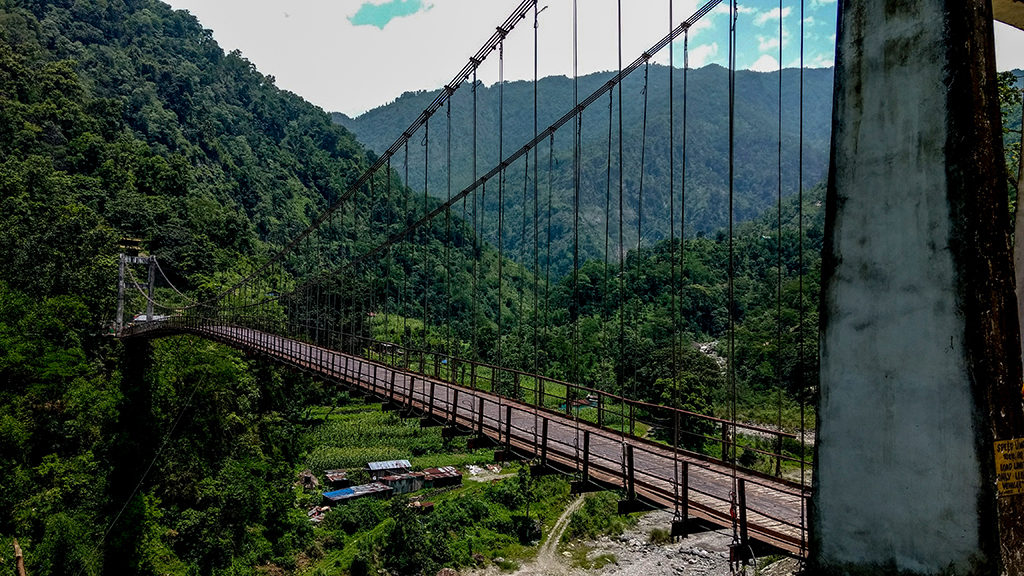
After we cross the bridge, the trails noticeably start gaining altitude. An hour after crossing bridge you will reach Bakhim which is at 7167 feet above the sea level. We will rest for night in hut house or tents pitched here. The view of the whole yuksom valley looks amazing from Bakhim.
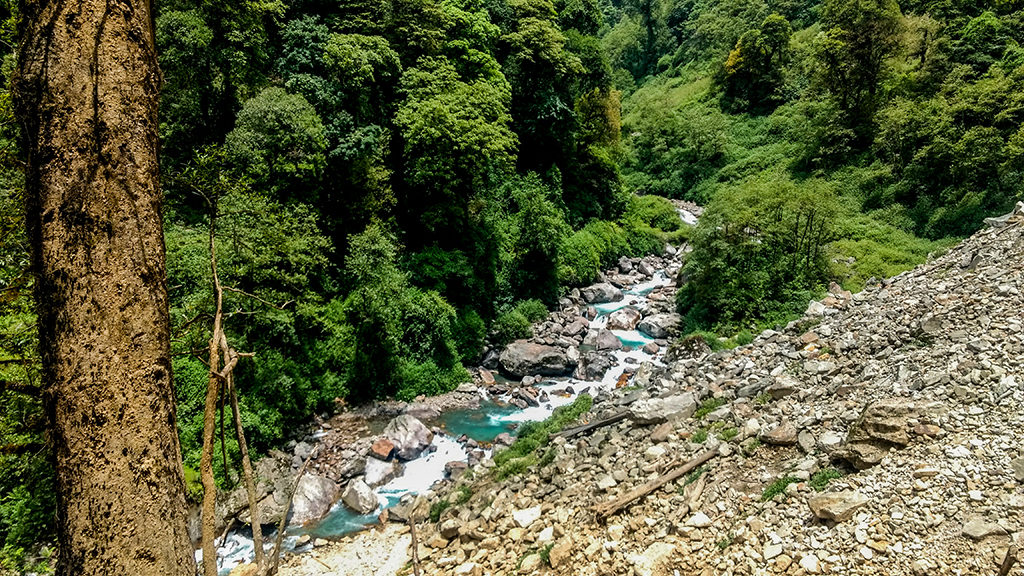
Day 3: Bakhim to Tshoka
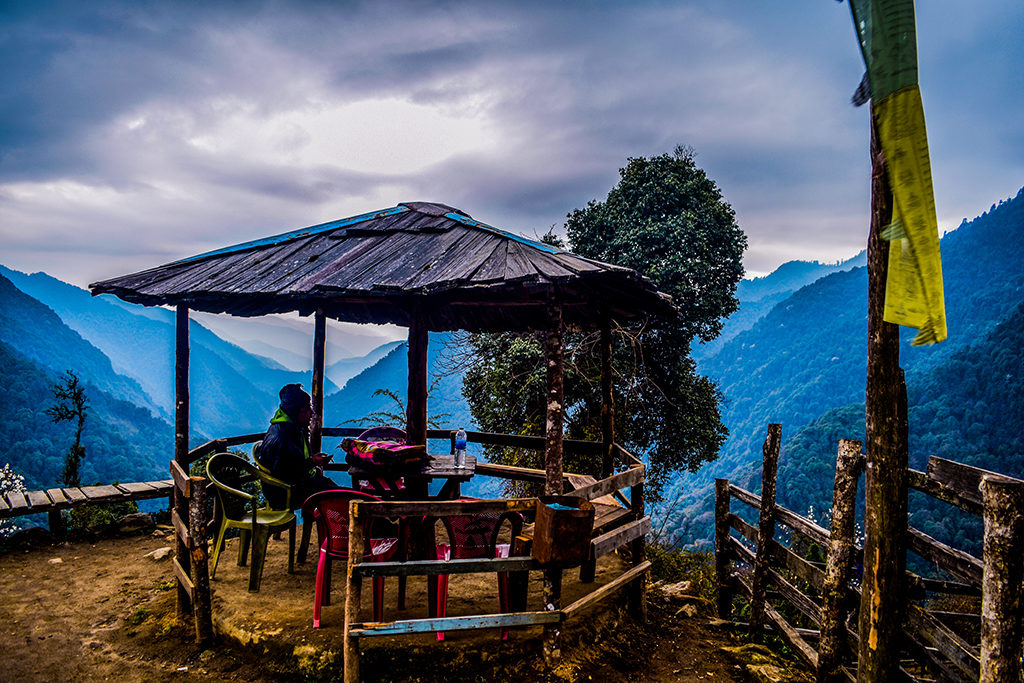
This trail is filled with wild strawberries and dense rhododendron trees. We will have multiple resting points on this part of the trek. After a trek of 3 to 4 hours we will finally reach our second camp site of Goechala Trek I.e., Tshoka. It is small village of 20 trekkers hut with flat camping area to the right of the trekker's huts and a small monastery beside a beautiful lake.
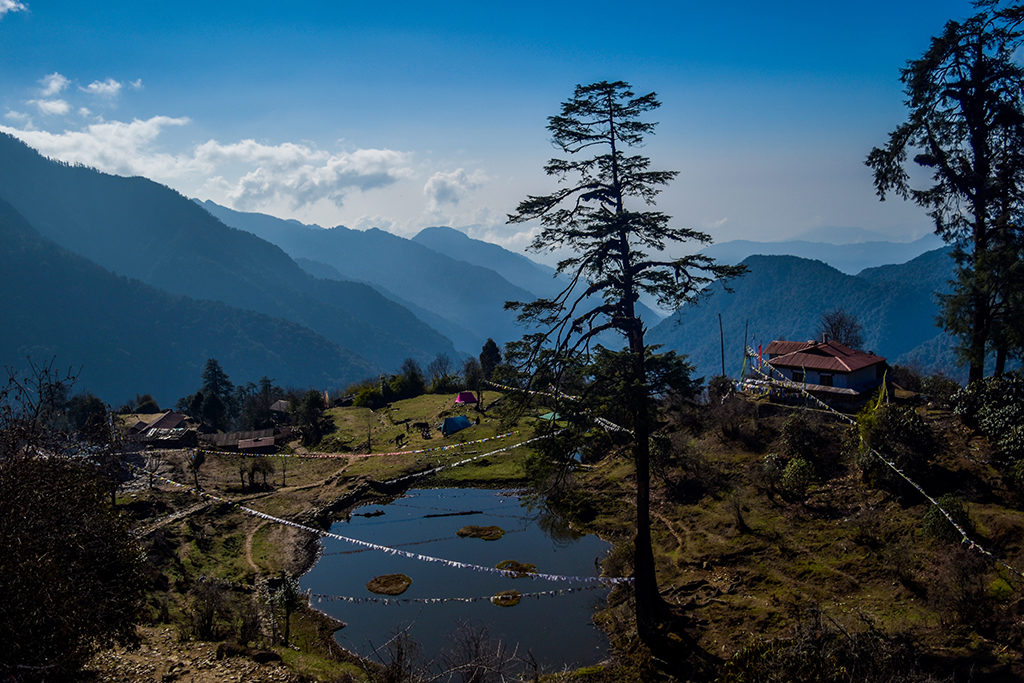
You can reach the monastery by following the trail little above Tshoka forest rest house. The monastery is a worth visits for its quietness and Tibetan architecture. The best part of this place is that you will some of the high mountains of the Kanchenjunga range from here with Mt. Pandim dominating the most.
Day 4: Tshoka to Dzongri
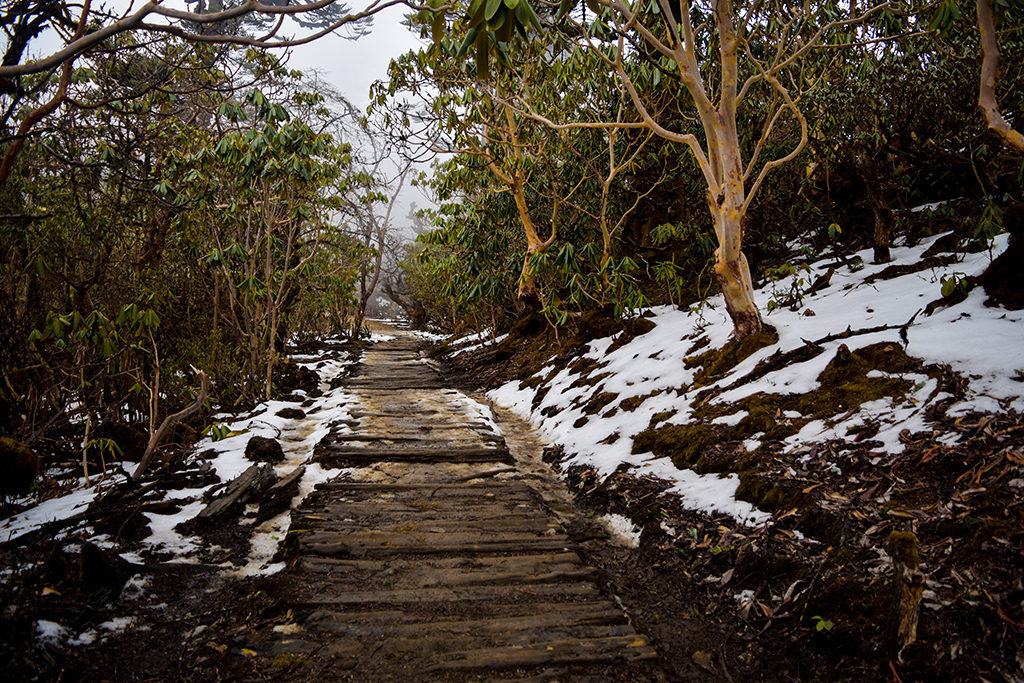
If you are trekking during April to May month which is the flowering season the region, As the trail goes through thick forest of rhododendron trees, you will witness the trail like a carpet of red rhododendron flowers. After a half or an hour, you will reach our first break point i.e., Phedang. What gives away this place is the small hut house towards your left. This cross gives two ways, one to your right which leads to Kockchurang and straight leads to Dzongri. We will continue our ascend to the Dzongri route.

After an hour or so, the view will open up as you climb above the thick forest of tall trees. After the second break point, the trail becomes like a camel hump, sometime you gain altitude and sometimes you lose altitude. At every high point of the ascend you will be greeted by the ridge of high mountains to your right. It would take close to 5 hours for us to reach Dzongri trekkers hut house. Dzongri is close to 3000 feet above Tshoka and it surely give a welcome vibe after a hard climb. It is a small hamlet of 5-6 trekkers hut house surrounded by high snow-clad mountains from all sides.

Day 5: Dzongri to Dzongri Top (Rest day at Dzongri)
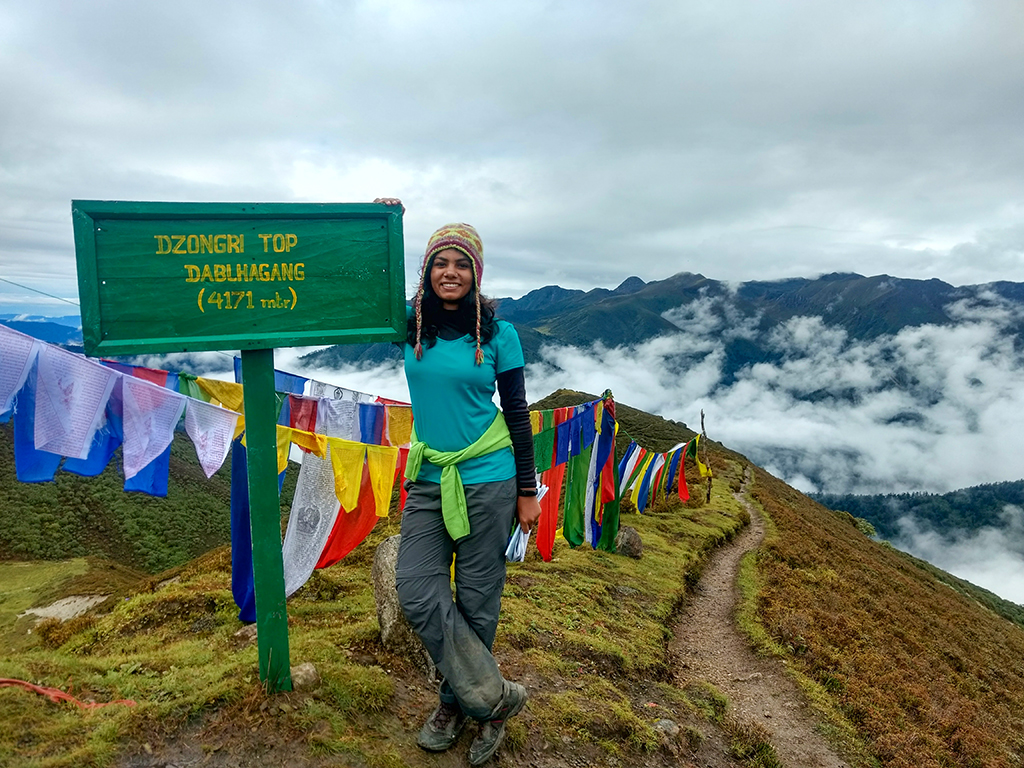
Dzongri Top gives a beautiful 180 degree of panaromic view of the whole Mt Kanchenjunga range. As the sun climbs up the whole valley fills with color and mighty mountains of Kanchenjunga range makes their appearance.

This magical moment surely is a reward to the hard climb from Yuksom.
Day 6: Dzongri to Thansing via Kockchurang
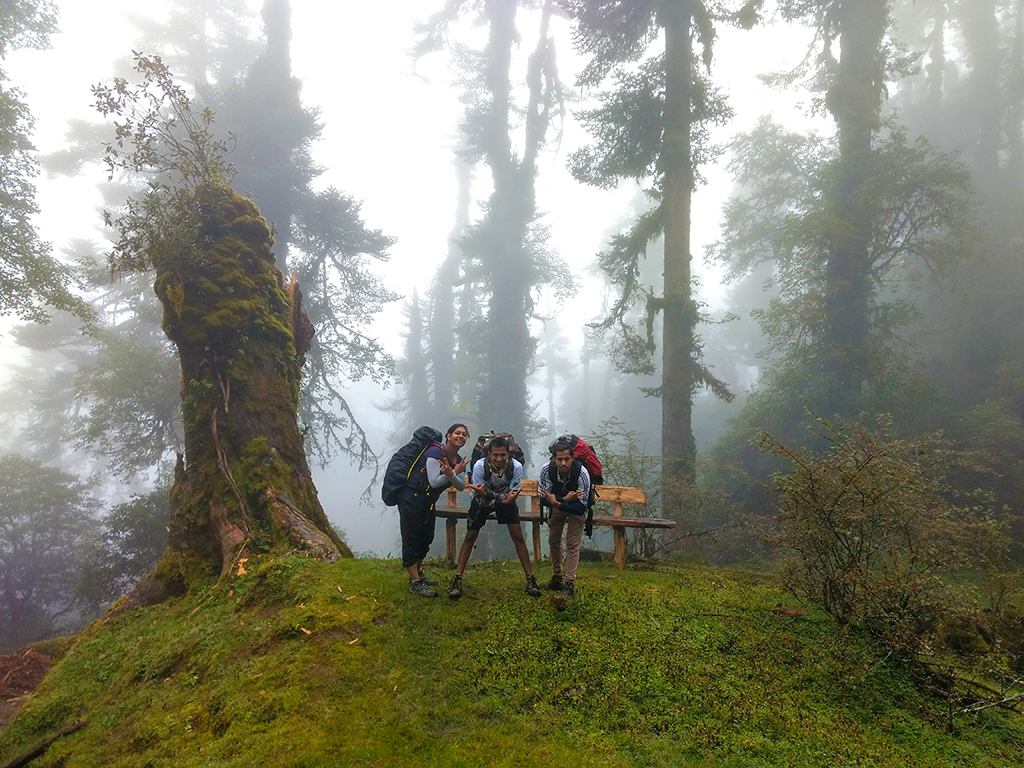
We will spend some time by the river enjoying its flow and then cross the river to the other side. After we cross the bridge is trail starts gaining altitude till the midway then it a meadow walk for close to 2 km till we reach Thansing. The trail again goes through dense forest of trees. You would be camping just in front of Mt. Pandim to the right and Mt Kanchenjunga to your left.
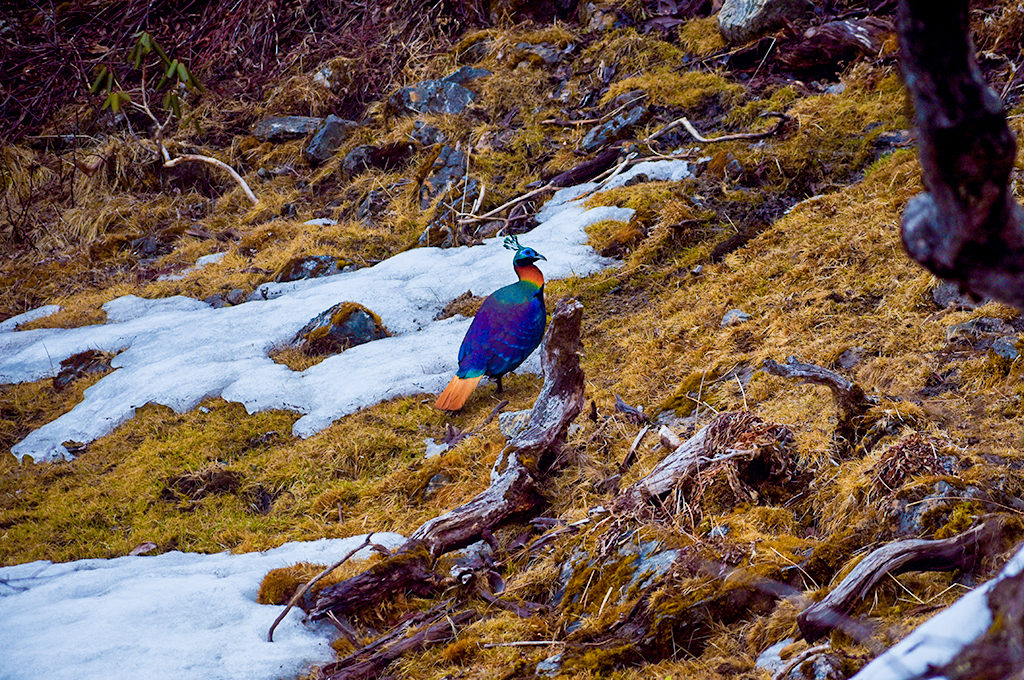
Day 7: Thansing to First View Point and back to Thansing
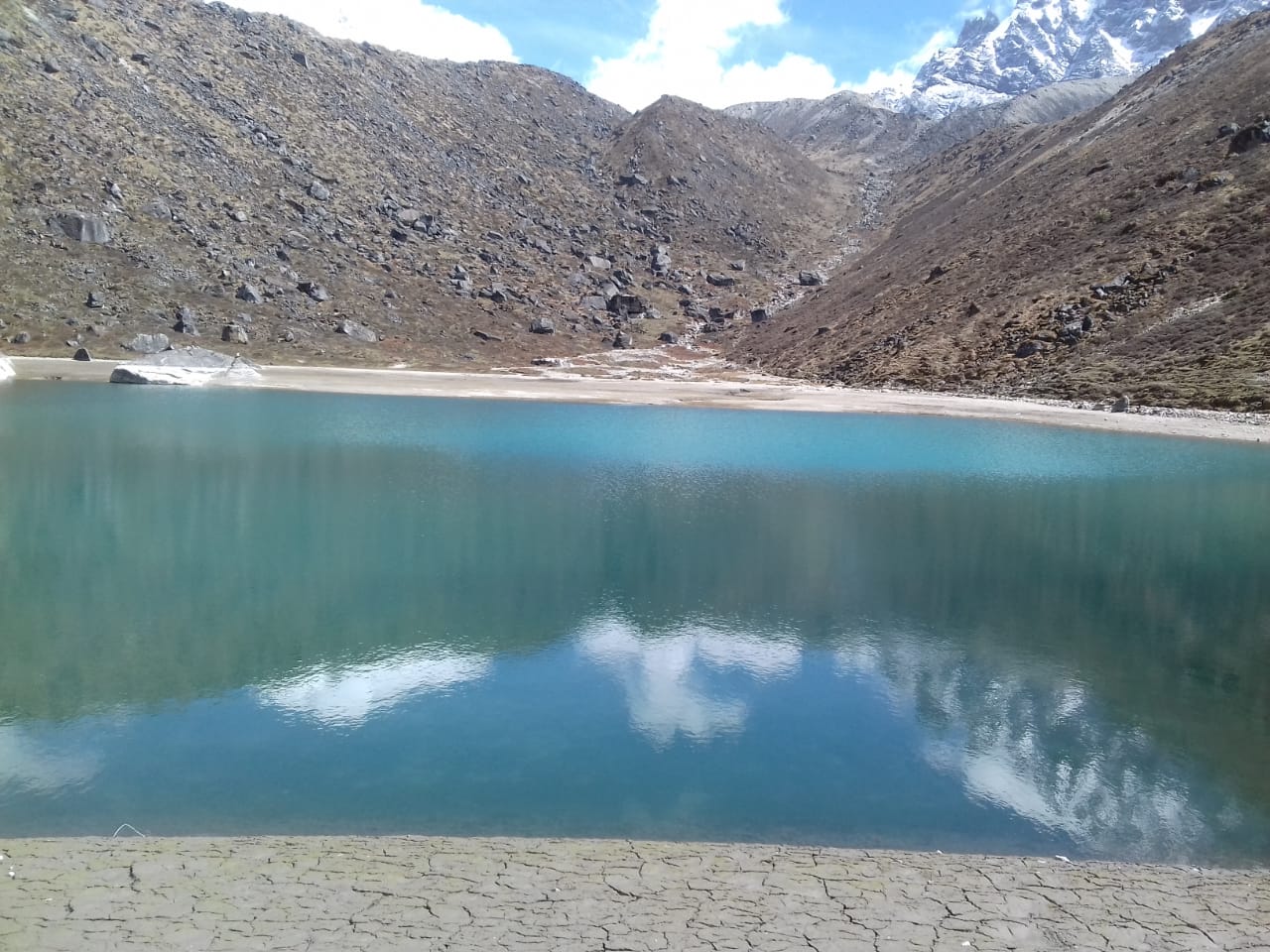
The initial trail is meadow walk with moderate ascent at some points till we reach Samiti Lake (beautiful deep blue water lake). After which the trails start to ascend till we reach the Goechala first view point. The most alluring moment of the day it the enchanting view of sun rising over the Kanchenjunga range and illuminating the whole mountain range like a glowing chain of gold.
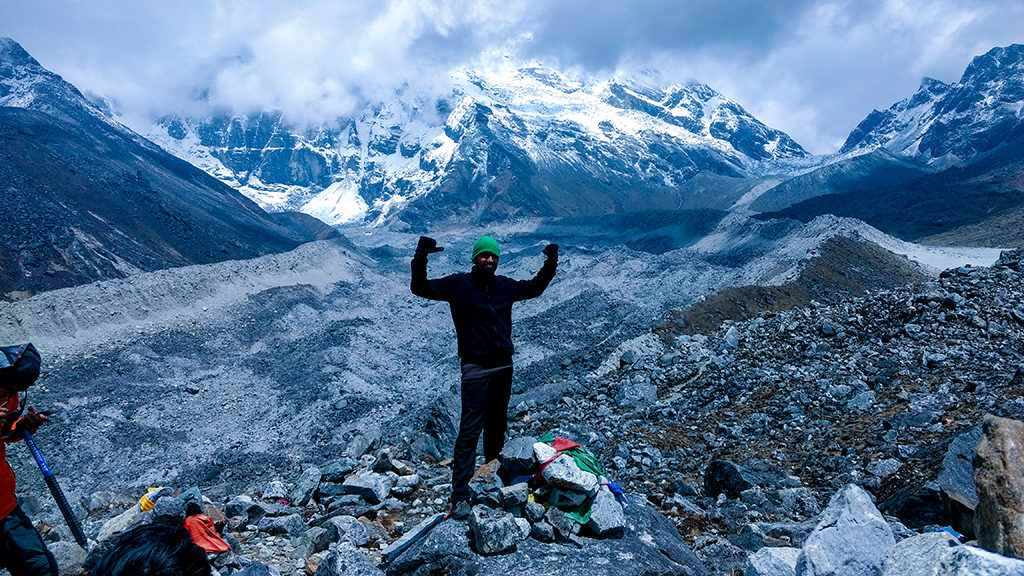
After spending some time at the Goechala view point, we will start our descend to Samiti Lake and enjoy a relaxing moment while summing up the whole journey of the trek. From there we will come to Lamuney and continue our meadow trail till we reach Thansing.
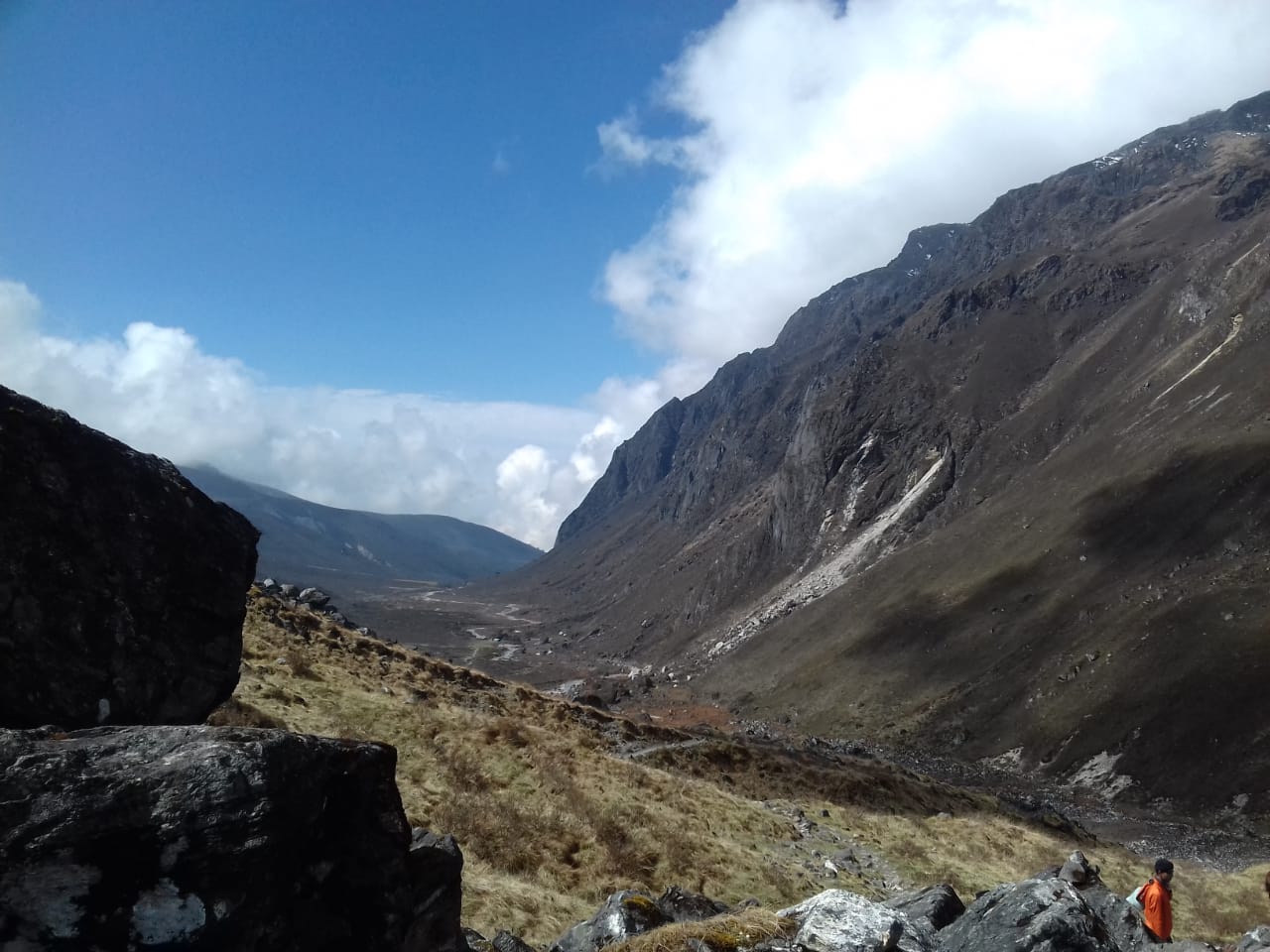
Day 8: Thansing to Tshoka
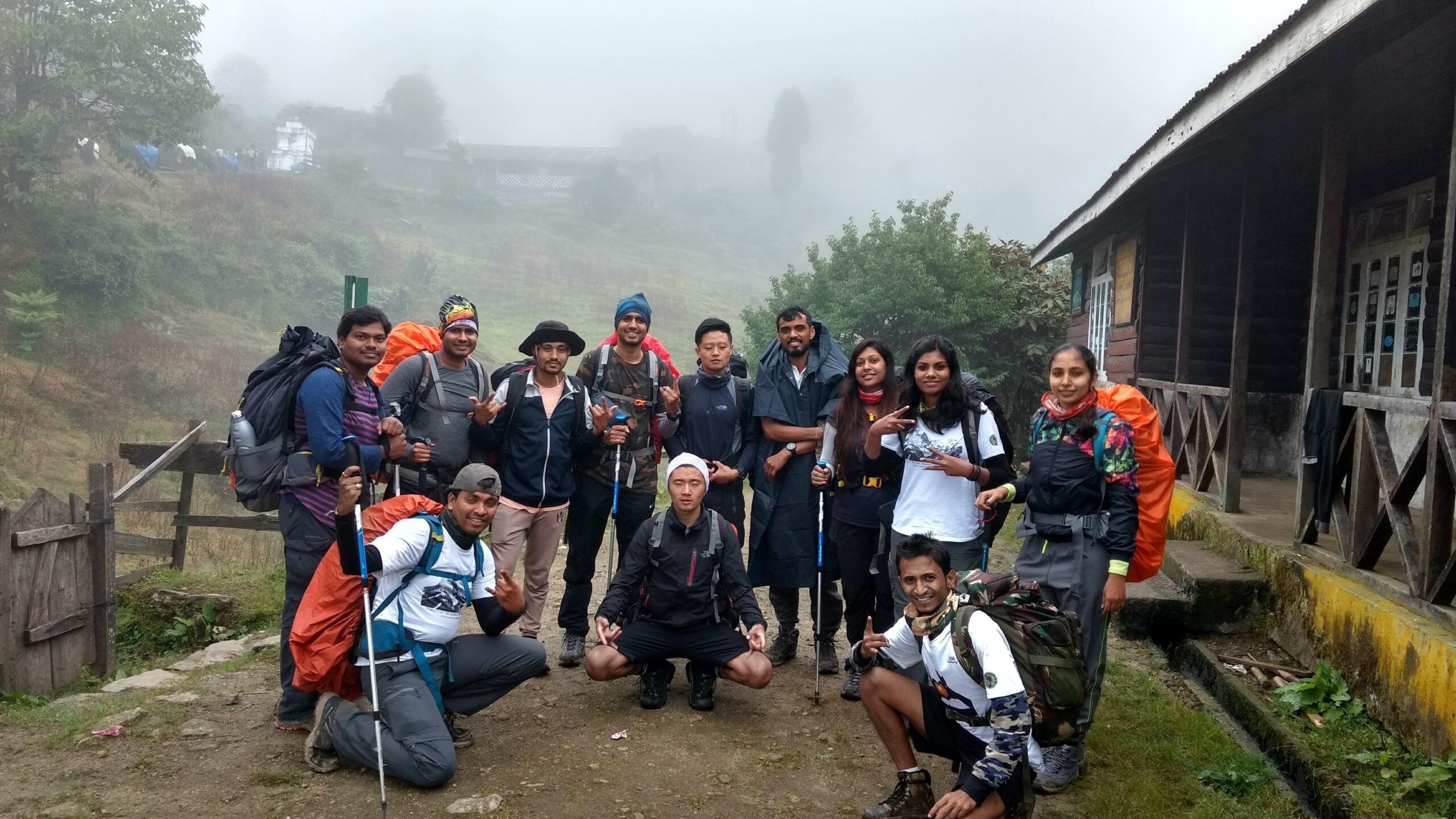
Day 9: Tshoka to Yuksom
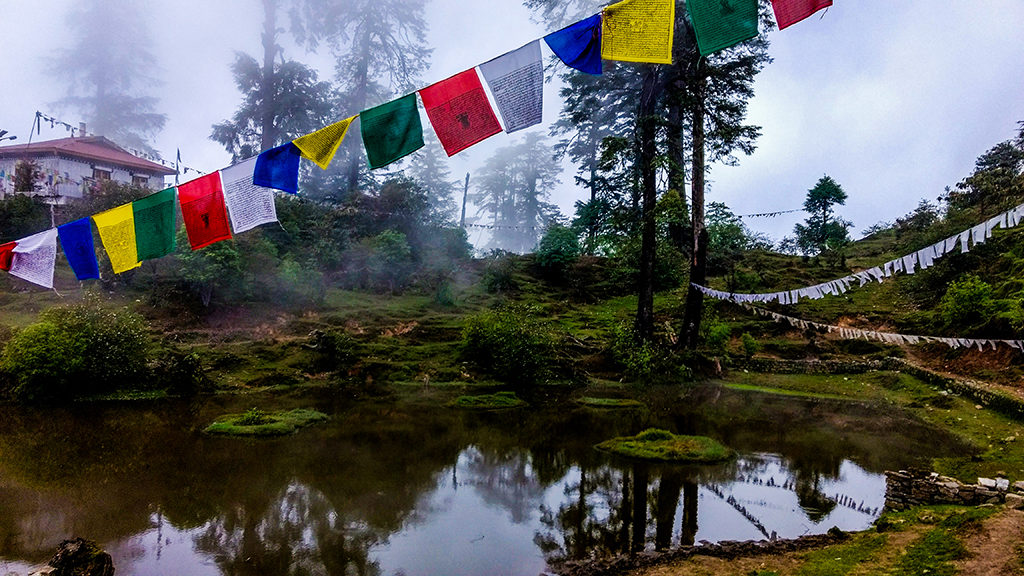
Day 10: Departure from Yuksom with hard earned memories
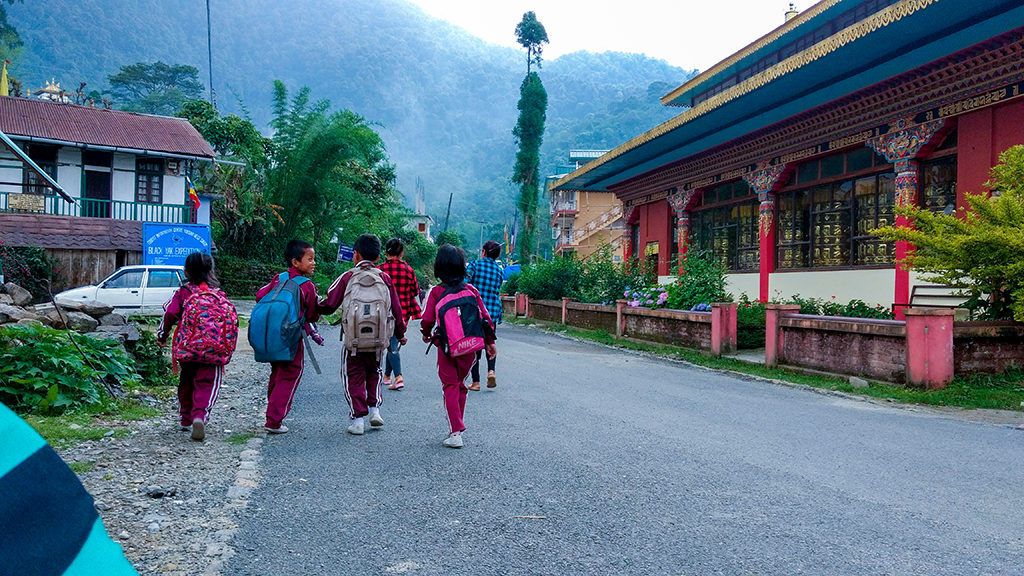
Special Permit for Foreigners planning to do Goechala Trek
You need to do the following steps to obtain the permission to do Goechala Trek:
- Obtain ILP (Inner Line Permit) : Please register yourself to the link: http://sikkim.nic.in/homedept/ilpfaqs.htm to obtain the ILP certificate. You can also obtain this permit outside Bagdogra Airport or at the check post at the gate while entering Sikkim.
- Special Trek permit from Gangtok: You would need to take a special trek permit to do any trek in Sikkim from Gangtok. Nature walker leader or local guide will help you obtain this permit. You would just need to come to yuksom one day before the trek day to give time to our representative to obtain permit for you. This permit varies from Rs, 2000 to Rs, 2500. To obtain this permit you would need your valid photo id proof.
- Forest check post permit: you also need to obtain forest permit at the forest check post at yuksom which will cost you additional Rs, 2000 to do the trek. To obtain this permit you need a valid id proof.
Things to Carry
- Xerox Copy of you Aadhar/Voter ID (Mandatory requirement for forest permit)
- Water Bottle – 2 (1 liter each)
- Raincoat – if in case it rains.
- Torch with New Batteries
- Shoes with good traction on it.
- One cover sheet – Good to have one
- A cap
- Cargo/track pants -2
- T-shirt -2
- Extra pair of Socks
- Personal medication kit
- Soap
- Toothpaste
- Toothbrush
- Sunscreen
- Rain Coat/Poncho
- Flip-flops
- Portable chargers
- One bag to keep wet cloths
- Little extra cash for meal not included in the itinerary
Refund & Cancellation
- Please check out the cancellation policy:
- https://naturewalkers.in/cancellation-policy/
- you can send your cancellation request to connect@naturewalkers.in
Safety,Risk and Advisory
FAQs
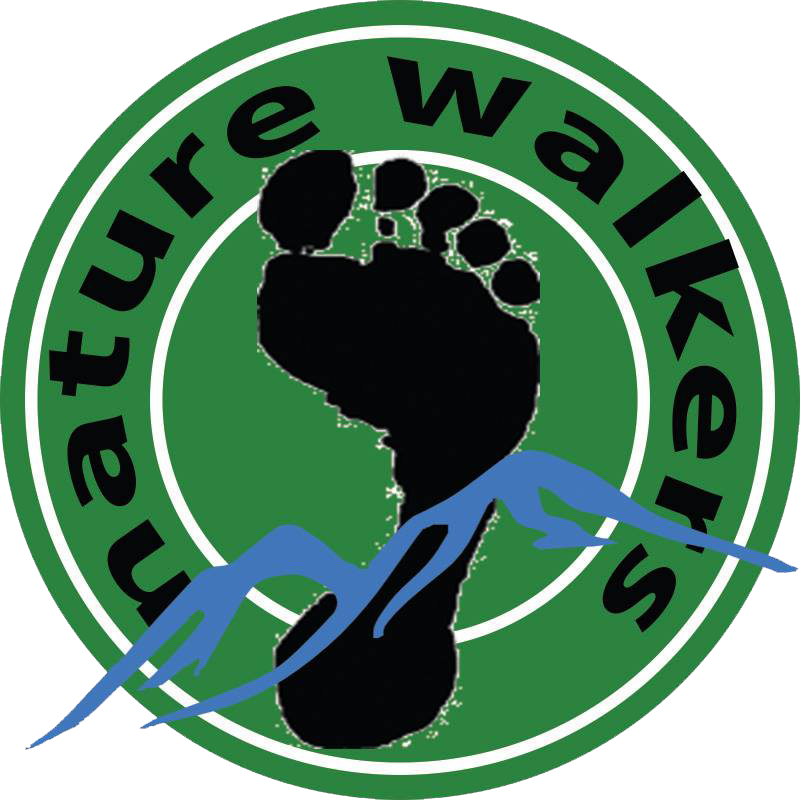
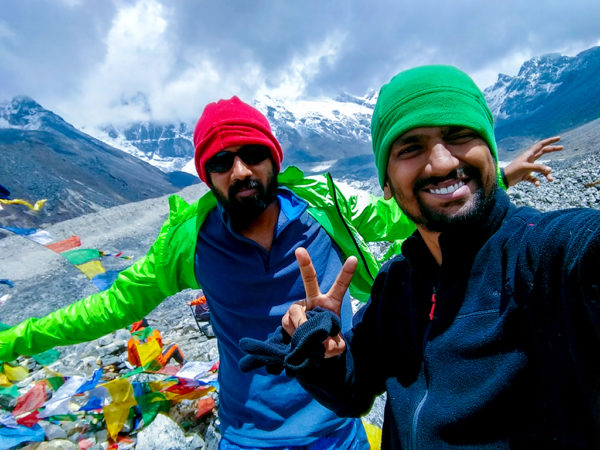
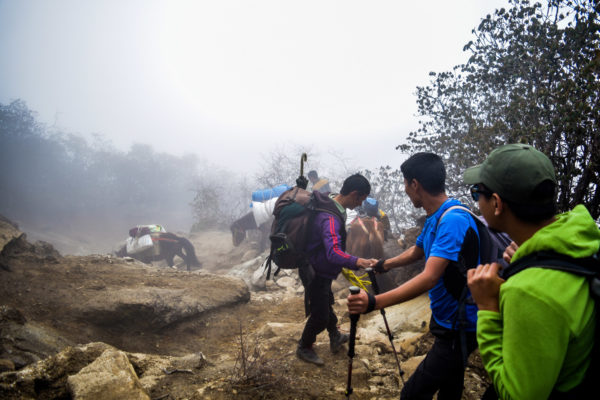

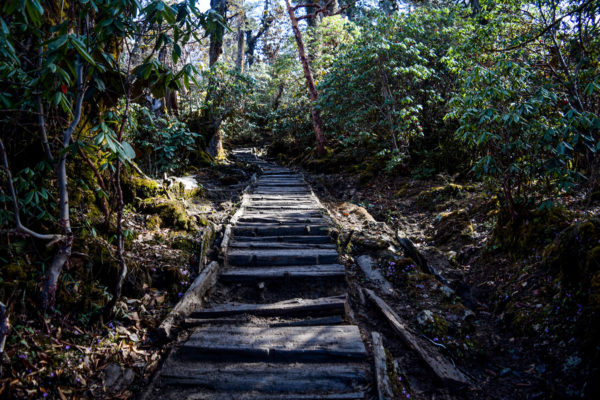
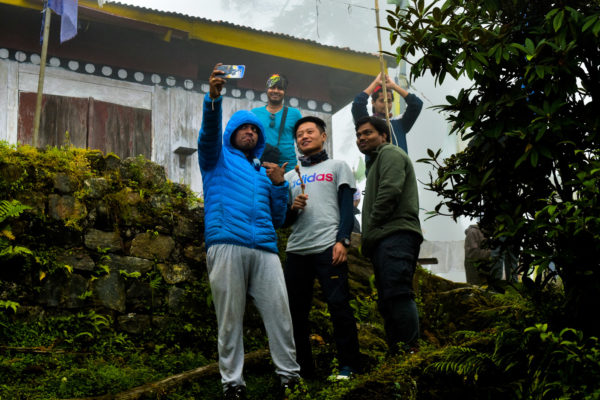
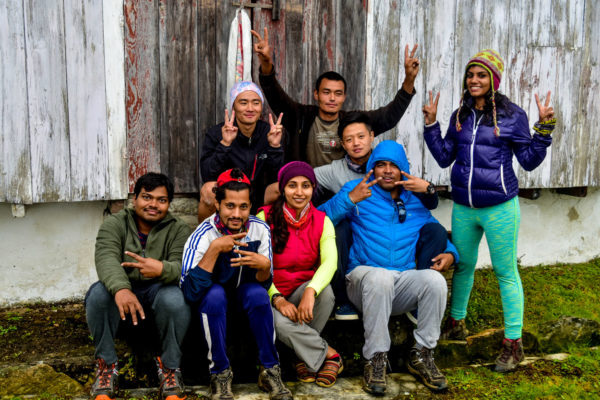
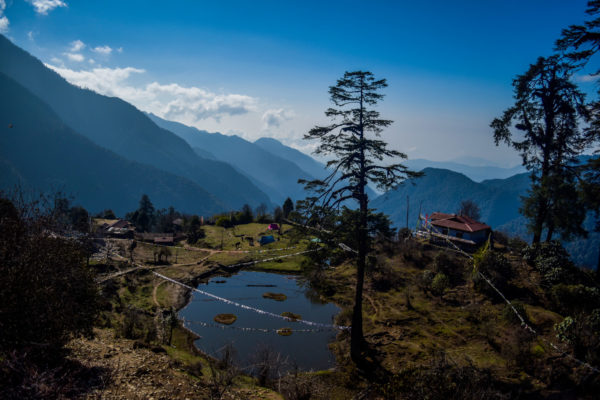
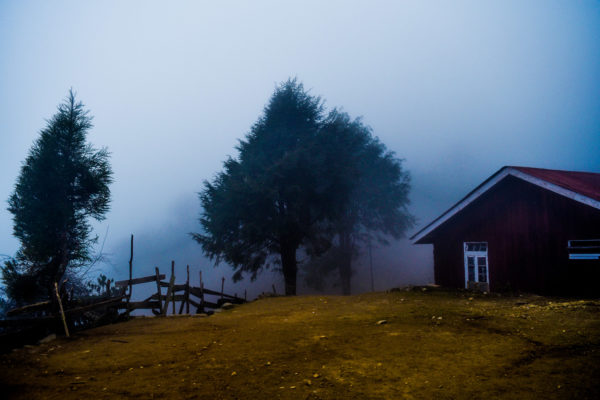
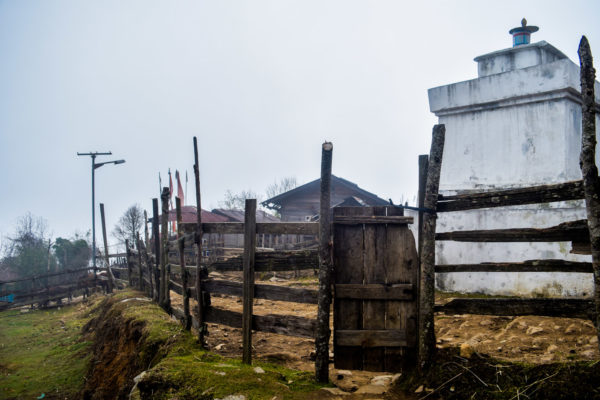
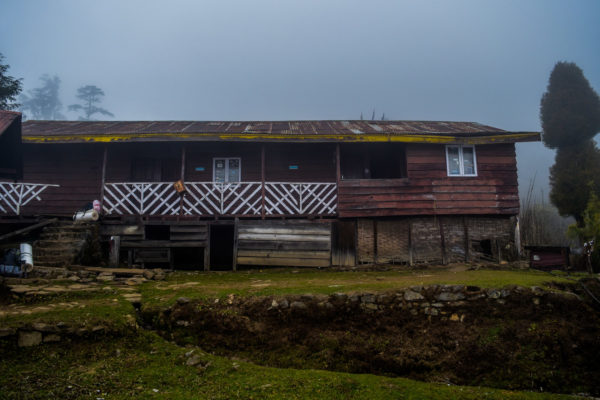
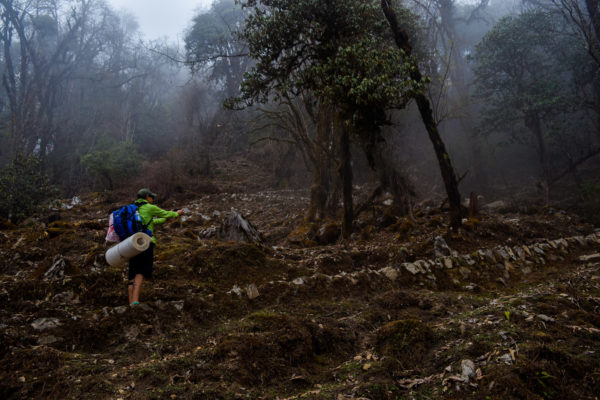
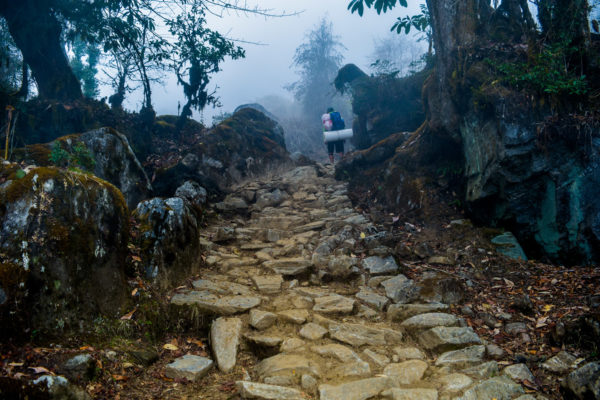
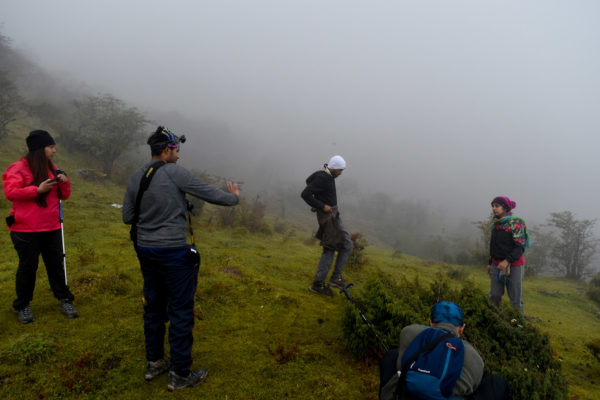
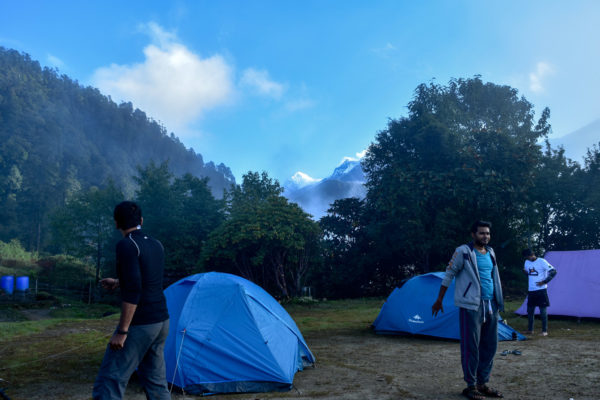
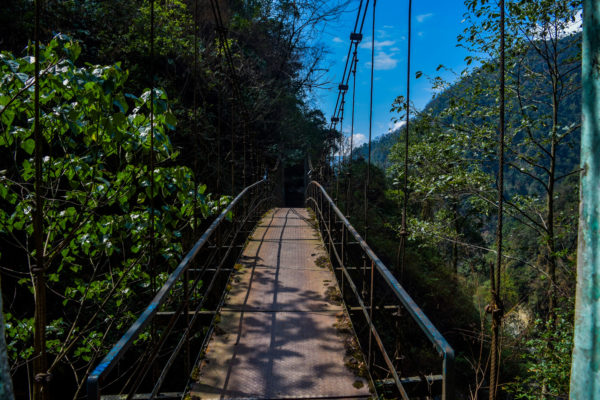
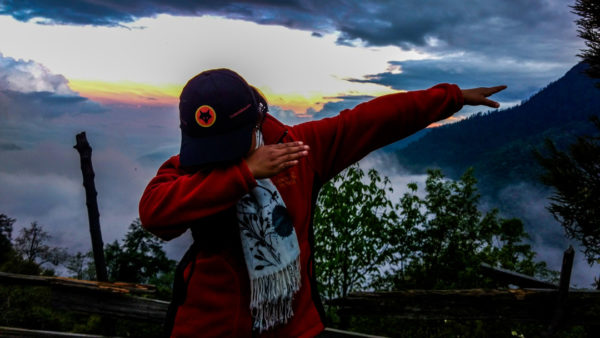
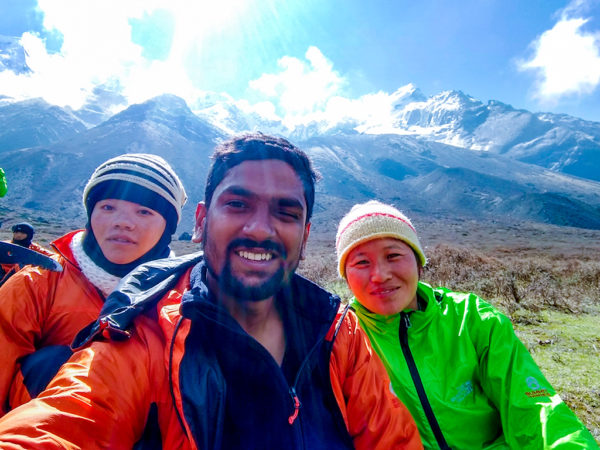
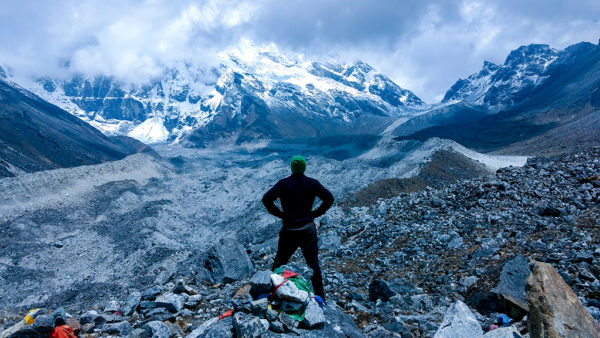
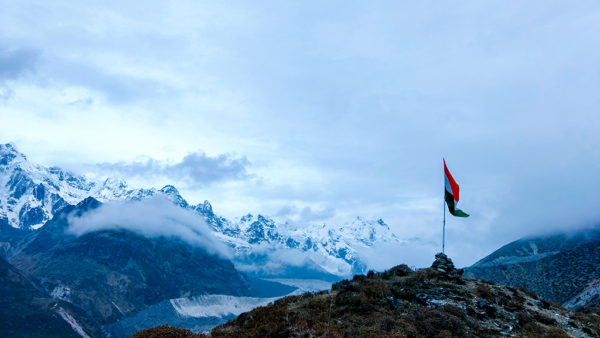

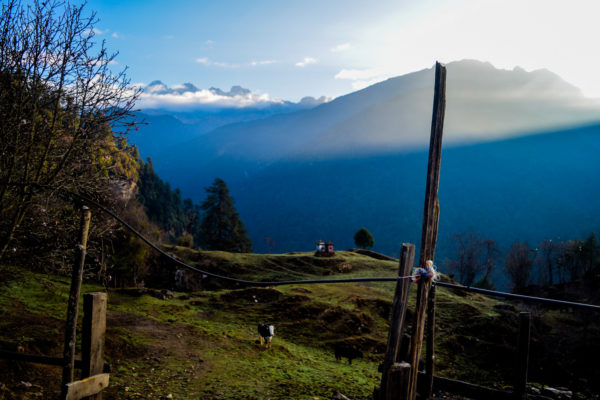
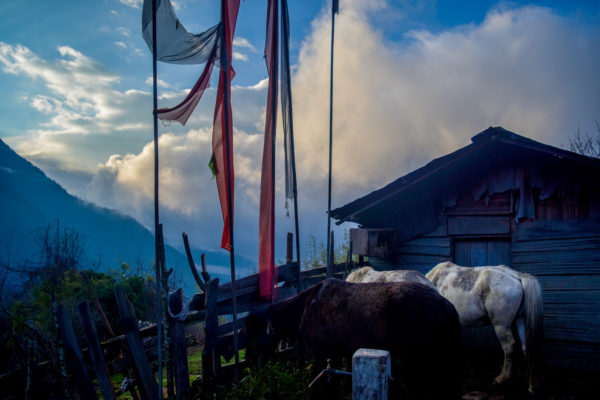
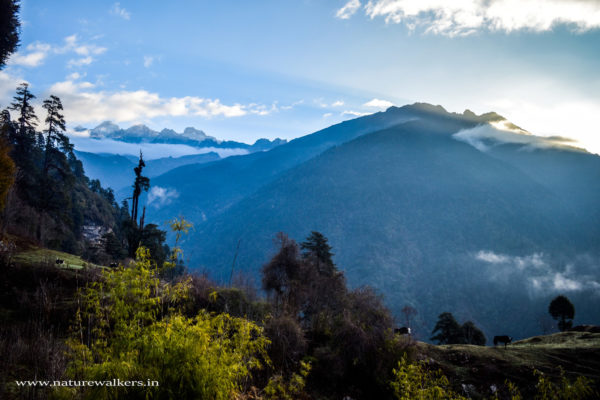
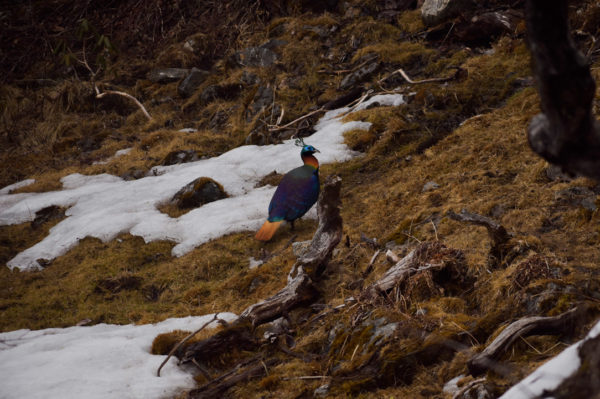
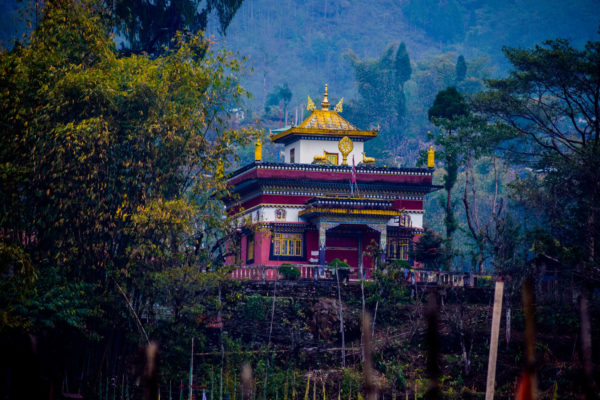
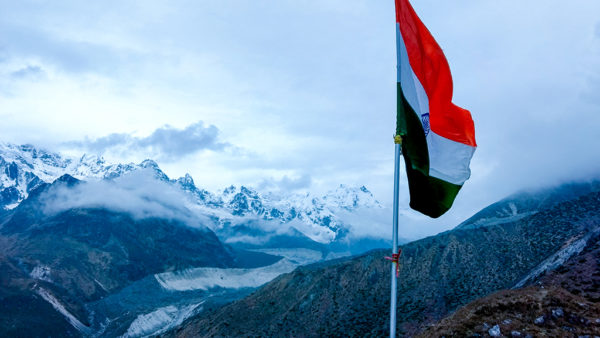
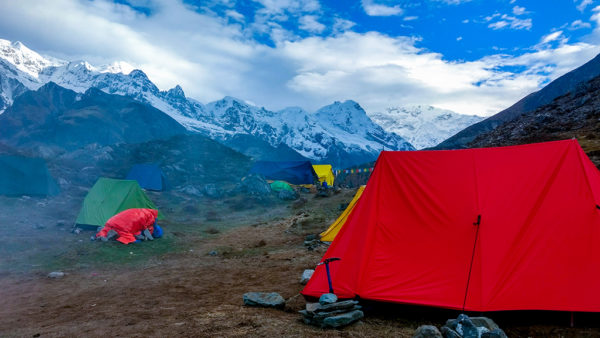
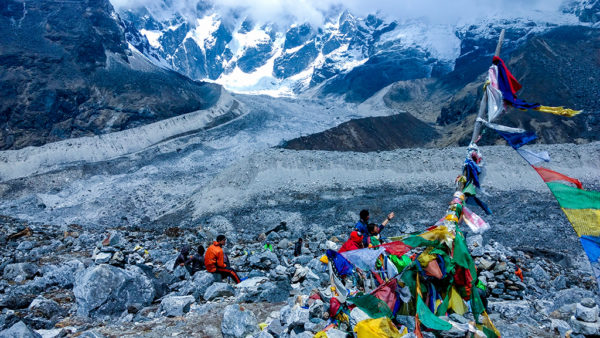

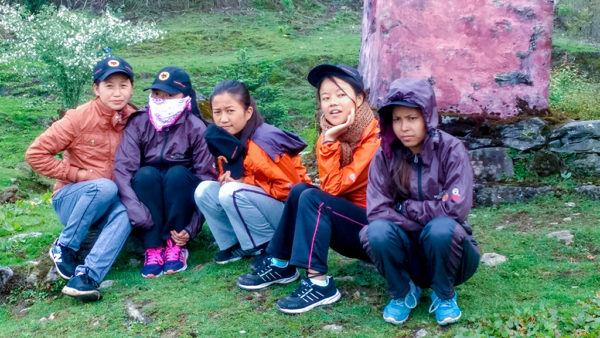
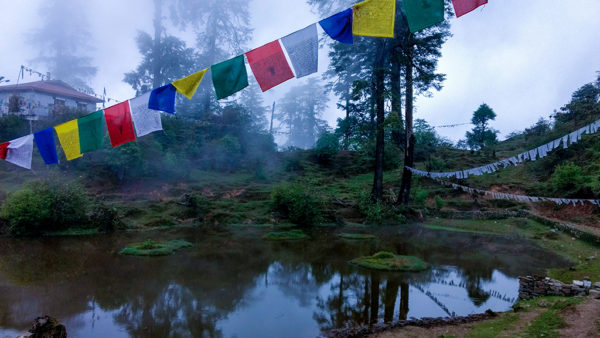
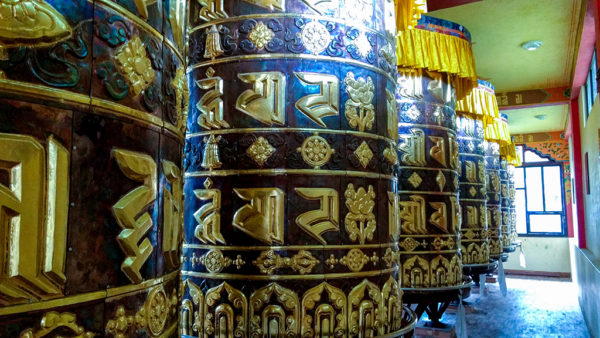

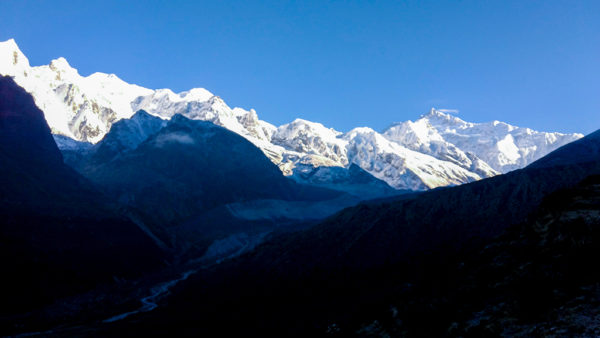
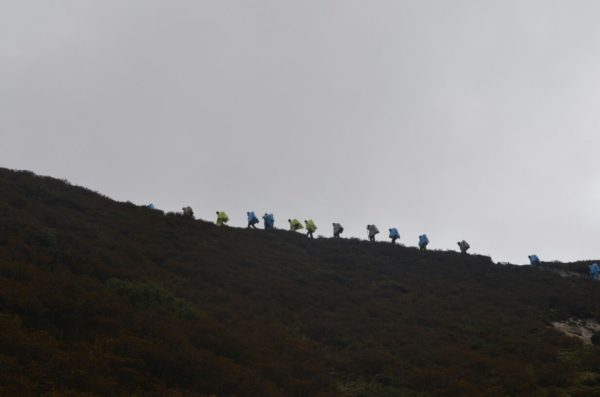
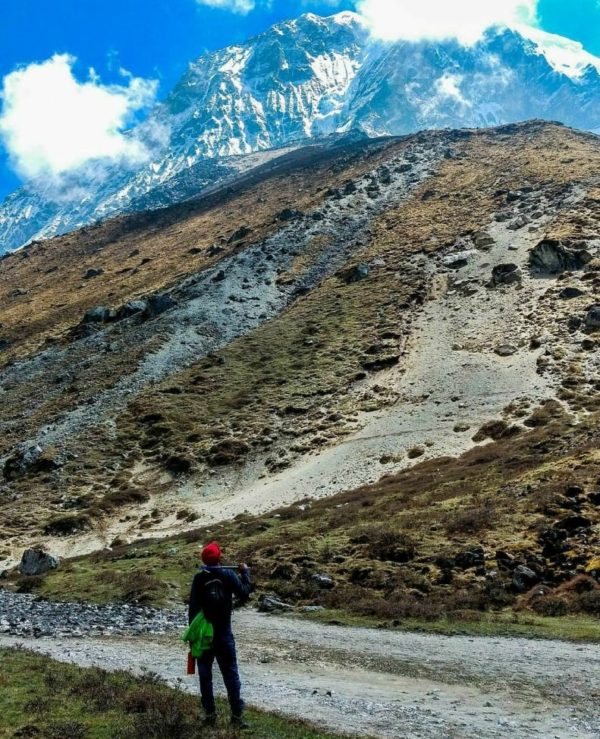

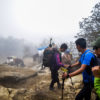
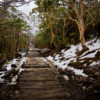
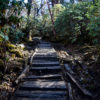
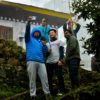
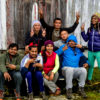
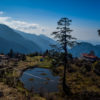
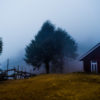
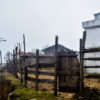
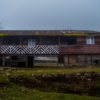
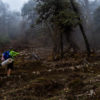
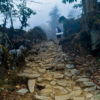
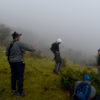
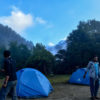
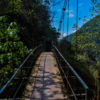

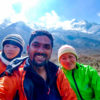
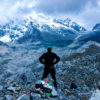
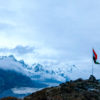
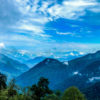

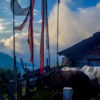
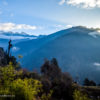
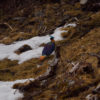
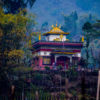
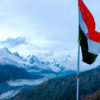
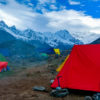
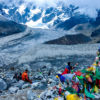


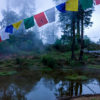
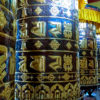
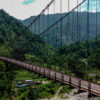
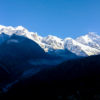
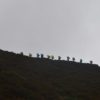

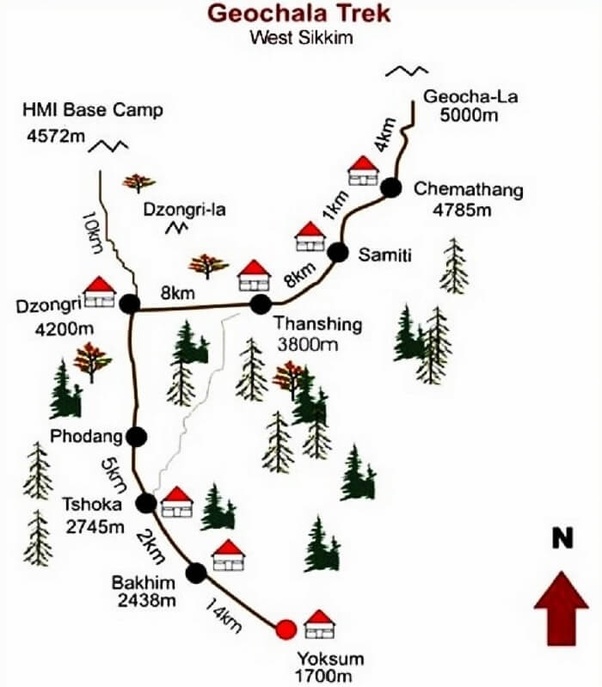
Reviews
There are no reviews yet.